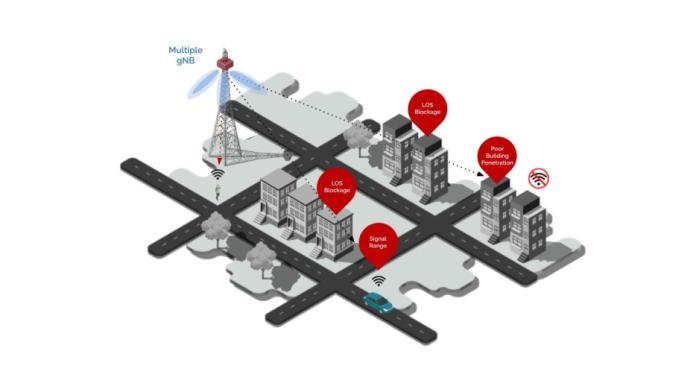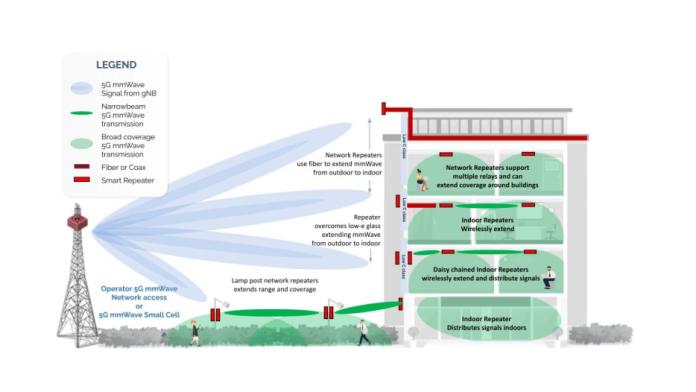New technologies often follow Gartner’s classic hype cycle, progressing from initial innovation to overenthusiasm and disillusionment to enlightenment and eventual productivity. 5G is no exception. As the bold headlines and hype surrounding 5G give way to practical realities, advocates and critics alike agree that a number of technical issues must be resolved before 5G reaches its full potential. 5G networks based on millimeter-wave (mmWave) frequencies in the 24-GHz to 40-GHz range hold the most promise for high-bandwidth and low-latency wireless connectivity. However, mmWave technology also poses significant RF propagation challenges and obstacles to deploying super-fast 5G networks at scale that designers need to tackle to unlock the potential of 5G everywhere.
5G transformation: Wireless networks with fiber-like speeds
Cellular evolution is never-ending: 2G enabled text messaging, 3G brought mobile internet connectivity, and 4G introduced mobile streaming video. 5G New Radio, the fifth generation of cellular technology, is poised to succeed today’s 4G LTE, delivering peak data rates 100× faster than 4G, along with dramatically higher bandwidth, lower latency, greater availability, and more consistent coverage.
5G will be a catalyst for innovation in how we live, work, and connect, transforming industries and enhancing our lives in ways we’ve yet to imagine. Just as the proliferation of high-speed fiber communications revolutionized the internet, 5G networks will supercharge mobile connectivity everywhere. Fiber-like 5G speeds with 10× spectrum availability will blur the lines between wired and wireless access in our homes, offices, factories, and cityscapes.
Applications benefitting from 5G’s unmatched performance include fully autonomous vehicles, vehicle-to-vehicle communications, smart buildings and smart cities, telemedicine, medical robotics, virtual and augmented reality, mobile cloud-based services. An exponential increase in connected devices for the internet of things and industrial IoT smart factories, warehouses, and sports arenas will be among the first movers to benefit from private 5G networks.
mmWave: The 5G technology we all want
Just as there are multiple flavors of Wi-Fi and Bluetooth wireless technologies with varying features and levels of performance, mobile carriers are rolling out several types of 5G with significant differences in speeds and latency based on the spectrum used.
There are two primary types of 5G networks:
- Super-fast mmWave 5G networks are based on ultra-high–frequency bands ranging from 24 GHz to 40 GHz and even higher, delivering the blazing-fast performance, broad bandwidth, and “wow factor” that most people expect from 5G. This is the 5G frequency range that enables full-length movies in seconds rather than minutes.
- Sub-6-GHz 5G networks — what most people are currently experiencing in their 5G service — support mid- and low-frequency bands below 6 GHz. Low-frequency bands are less than 1 GHz, and mid-bands range from 3.4 GHz to 6 GHz.
Understanding the differences between each type of 5G technology is crucial to addressing deployment challenges and meeting end-user expectations for bandwidth and latency. The type of 5G that most users are receiving today on their smartphones isn’t the ultra-fast, multi-gigabit 5G they immediately expect.
4G LTE networks are dramatically slower than mmWave 5G networks, with 4G download speeds ranging from about 35 Mbits/s to more than 50 Mbits/s. mmWave can deliver speeds as high as 5 Gbits/s, considerably faster than what is possible with 4G LTE. Sub-6-GHz 5G network speeds fall somewhere between mmWave and LTE speeds. While sub-6-GHz networks outclass 4G LTE in terms of throughput, latency, and bandwidth, they fall short of mmWave performance.
Most consumer and business users will not pay the premium to switch from 4G to 5G unless they see dramatic improvements in data rates, latency, and bandwidth. mmWave is the only form of 5G technology that offers a noticeably superior user experience. It’s the 5G we all want.
mmWave 5G rollout: Challenges and opportunities
The enormous potential of mmWave technology comes with major challenges. Real-world mmWave network speeds vary greatly depending on range, signal blockers, and proximity to the nearest 5G tower or small cell. While mmWave 5G networks are ultra-fast, they’re also very short-range. To receive mmWave signals, users must be within a block or two of a 5G tower with no line-of-sight (LOS) obstructions. High-frequency mmWave signals are easily blocked by buildings, walls, windows, and foliage, further reducing the available 5G range (Figure 1). To optimize coverage, carriers are faced with installing numerous small cells in high densities, driving up the cost of deploying mmWave networks at scale.

Figure 1: Service provider challenges to rapid 5G mmWave deployments include limited signal range, line-of-sight requirements, poor building penetration, and coverage and connectivity. (Source: Movandi) Click for a larger image.
Because of its coverage and LOS limitations, mmWave technology is better-suited for dense urban environments. Due to its range limitation, mmWave is not a practical choice for suburban and rural areas, which are best served by easier-to-deploy, more affordable 4G LTE and sub-6-GHz 5G networks. Widespread deployment of mmWave 5G networks will require extensive underground installation of fiber cable. Until this happens, carriers will continue to rely on existing network infrastructure while the market transitions to 5G. Moreover, today’s smartphones do not support all types of 5G. However, Apple and Samsung are expected to launch new 5G-enabled smartphone products in the near future.
Although range, signal propagation, and LOS limitations are mmWave’s “Achilles heel,” advanced technologies such as massive multiple-input multiple-output, miniaturized antenna arrays, adaptable beamforming, and smart active repeaters can effectively address these challenges.
Smart active repeaters solve 5G signal propagation challenges by amplifying mmWave signals and extending the range and coverage of mmWave-based networks in outdoor environments and inside buildings. Active repeaters work by boosting mmWave signals, enabling them to penetrate walls and other blockers and bend around buildings to overcome LOS issues without the need for bulky antenna designs or costly fiber backhaul (Figure 2).
When deployed inside a building, a smart repeater amplifies a weak beamed signal and can light up an entire room, improving end-user and application connectivity experiences. Widespread use of active repeaters throughout 5G networks enables service providers to launch indoor, outdoor, and mobile enhanced 5G mmWave services at 50% lower costs.

Figure 2: Solutions such as Movandi’s BeamX-based active repeaters can increase the coverage of mmWave base stations by 90% for less than 40% of the capex cost. (Source: Movandi) Click for a larger image.
All major carriers in the U.S. are testing mmWave networks, providing availability in selected major cities and neighborhoods. Sub-6-GHz 5G is currently more widely available than mmWave, with major carriers rolling out lower-frequency 5G networks to many customers in urban areas.
Tier 1 operators are migrating to mmWave technology to meet network capacity requirements, as customer demand is expected to exceed sub-6-GHz capacity by 2023, with multiple operators already deploying mmWave-based 5G networks. While critics of mmWave argue that sub-6-GHz networks offer better coverage than mmWave and require fewer next-generation radio nodes (gNBs), limited sub-6-GHz spectrum will eventually require the deployment of more gNBs. Moreover, high-bandwidth mmWave will help relieve growing network congestion in crowded urban areas, such as sports arenas, concert venues, and airports.
While the transition to 5G networks is underway, there is still a long path forward until 5G supersedes 4G LTE, realizing the promise of ultra-fast mmWave speeds and low latency. mmWave technology is the key to unlocking the potential of 5G. To achieve 5G’s ambitious goals of low latency, high bandwidth, faster speeds, and broad coverage, major carriers and mmWave solution providers are working together to overcome these fundamental challenges.
Advertisement





